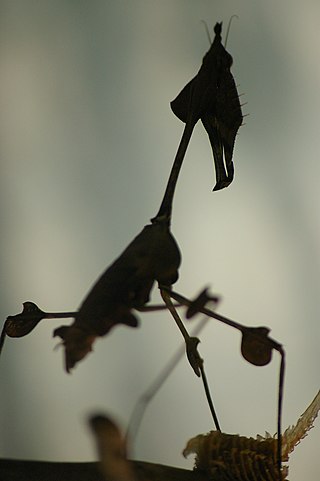
Mantidae is one of the largest families in the order of praying mantises, based on the type species Mantis religiosa; however, most genera are tropical or subtropical. Historically, this was the only family in the order, and many references still use the term "mantid" to refer to any mantis. Technically, however, "mantid" refers only to members of the family Mantidae, and not the 14 remaining families of mantises. Some of the most recent classifications have promoted a number of the mantid subfamilies to the rank of family, e.g. Iridopterygidae, Sibyllidae, Tarachodidae, Thespidae, and Toxoderidae, while other classifications have reduced the number of subfamilies without elevating to higher rank.

Metallyticus is a genus of praying mantis. It is the only genus in the monotypic family Metallyticidae. They are mostly found in South-East Asia. The species of the genus are dark, somewhat flattened and cockroach-like, and often with a cuticle that is reflective and metallic in appearance.

Mantoida is a genus of praying mantises in the family Mantoididae. The species of this genus are native to Mexico, Central America, and South America.

Gongylus is a genus of praying mantises in the family Empusidae. Characterized by extremely slender limbs with large appendages, at least one species is kept as a pet by hobbyists. Males of the species are capable of flight.

Paraoxypilus is a genus of mantis, known as the boxer bark mantises. They are native to Australia and Oceania.

Metallyticus splendidus is a rare species of praying mantis found in Southeast Asia. It has an iridescent appearance.

Myrmecomantis is a genus of praying mantises in the family Nanomantidae. It is monotypic, being represented by the single species, Myrmecomantis atra, commonly known as the ant mantis. It is a species that relies upon ant mimicry for protection even as an adult.

Iris is a genus of praying mantis found in Africa, Asia, and Southern Europe with one species, Iris oratoria, being introduced to North America in the south-western United States.

Rhombodera is a genus of praying mantises native to Asia and possessing common names such as shield mantis, hood mantis, and leaf mantis because of their extended, leaf-like thoraxes.

Chaeteessa is a genus of mantis. It is the only extant member of the family Chaeteessidae, the most primitive lineage of living mantises. It contains six species found in South America:

Oxyothespis is a genus of praying mantis in the family Toxoderidae. Members of this genus have been called grass mantises.

Toxoderidae is a family of praying mantises.
Catoxyopsis is a genus of mantis in the subfamily Vatinae. It consists of a single species, Catoxyopsis dubiosa.

Stenophylla is a genus of praying mantis in the subfamily Stenophyllinae, which is now placed in the family Acanthopidae. It the sole genus of the tribe Stenophyllini.
Epsomantis is a monotypic genus of mantis in the new (2019) family Nanomantidae. It represented by the single species, Epsomantis tortricoides.

Helvia is a genus of praying mantises in the family Hymenopodidae found in Southeast Asia. It is monotypic, being represented by the single species, Helvia cardinalis.

The Tenoderinae are a subfamily of praying mantids, originally used by Brunner von Wattenwyl. It was restored as part of a major revision of mantid taxonomy, and contains many genera previously placed in the subfamily Mantinae.

Liturgusa is the type genus of praying mantises of the family Liturgusidae. The genus consists of more than twenty species with a Neotropical distribution.

Titanodula is a genus of mantids in the subfamily Hierodulinae. There are currently five species placed in Titanodula. The genus is endemic to Asia and is distinguished from the similar genus Hierodula by the large size and unique male genitalia of its member species.
















